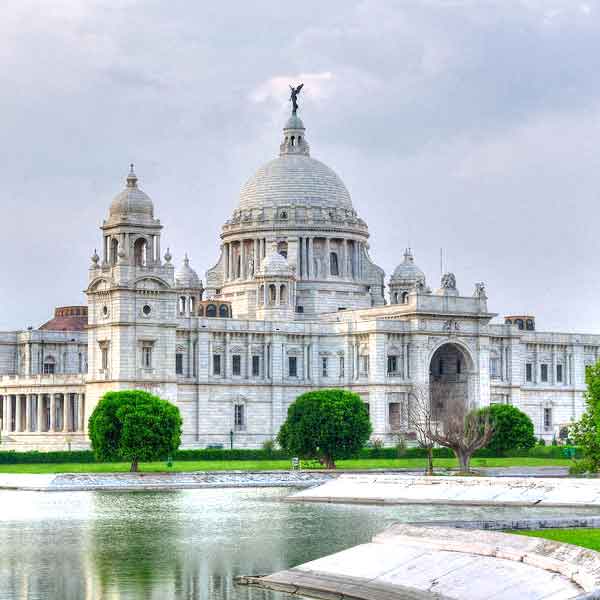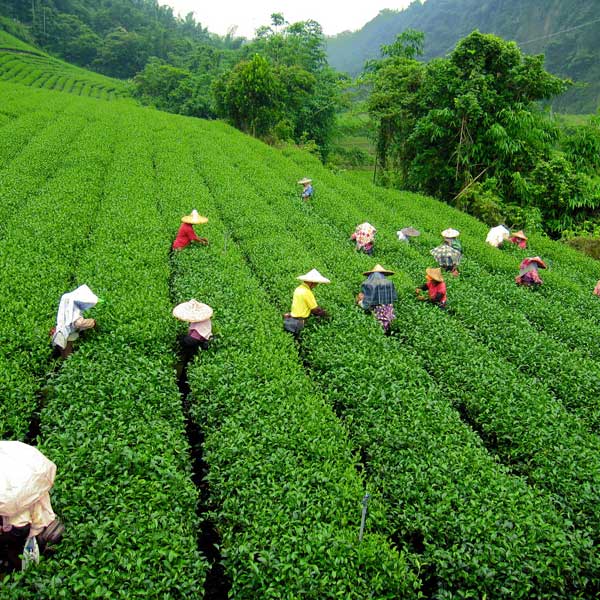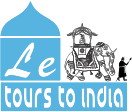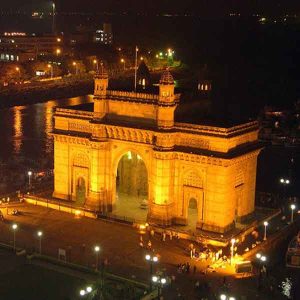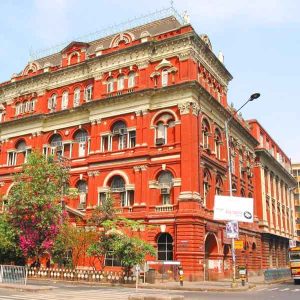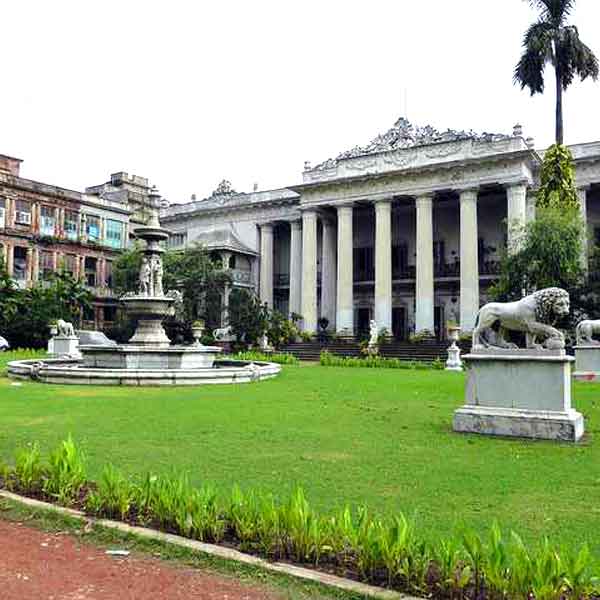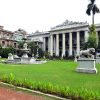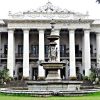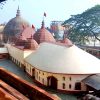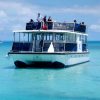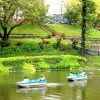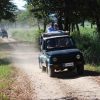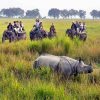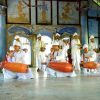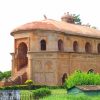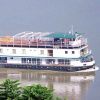Day 01: Arrive in Kolkata (Calcutta).
Arrive in the morning and transfer to your hotel for a two- night stay. Enjoy an afternoon city tour of India’s second largest city. Overnight in Kolkata.
Day 02: In Kolkata (Calcutta).
Our morning excursion will include a visit to the flower markets and a cruise down the River Hooghly. After lunch visit the Marble Palace and the South Park Cemetery, the last resting place of many of Kolkata’s early British settlers. Overnight in Kolkata.
Day 03: Kolkata to Guwahati (Assam) by Air.
Depart on a morning flight to Guwahati. On arrival drive up Nilachal Hill to see the holy Kamakhya temple which is one of India’s main centers for Shakti (Energy) worship and Tantric Hinduism and attracts pilgrims from all over India, especially during the Ambuchi Festival in August. It marks the legendary spot where the most procreative aspect of the Mother Goddess fell to earth.
Visit the poignant CommonwealthWar Graves cemetery. Finally walk through a local market before embarking on the RV Charaidew or the RV Sukapha (depending on departure date chosen). Set sail and cruise for about an hour and a half upstream to Kurua on the north bank.
Day 04: Ganesh Pahar.
The day is spent cruising upstream, with hills rising on either side, often battling against strong currents. We have time though to pause and visit the north bank village of Khirakata, with its lush green fields of vegetables and corn.
Day 05: Cruising.
Leaving the hills behind, we enjoy our first taste of the wilderness experience, sand banks like icebergs on either side. We may make a short stop to visit Tullugaon, another bankside village, with large sugarcane plantations. We shall see weavers at work in their homes, as well as the production of jaggery out of sugar cane juice. We moor for the night in a lunar landscape of sand islands, with hopefully the Himalayas in view and providing a contrasting backdrop in the distance.
Day 06: Tezpur.
We cruise on to Tezpur, where after lunch we visit the 6th century Da Parbatia temple ruins with a beautifully carved portal, then explore the town by cycle rickshaw, stopping at Cole Park with medieval stone carvings saved from sites all over the region, and aim to pass by the bungalow once lived in by Alexander Bruce, pioneer of the tea industry. Our ship will be waiting at the town’s waterfront for us to re-board.
Day 07: Nameri National Park.
After an early breakfast we drive for some two hours to the Nameri National Park at the foot of the blue hills of Arunachal Pradesh, the old North East Frontier Agency. Here we take a float trip of around two hours duration down the Jia Bhoreli River through the park, with excellent birdwatching (look out for the great hornbills) and perhaps the chance of sighting wild elephant. After lunch we take a village walk before returning to the ship.
Day 08: Kaziranga.
Continue upstream, passing below a seemingly endless new bridge across the vast width of the river bed, to moor at Steemer Ghat , a lovely beach backed by jungle-covered hills. In the afternoon we drive to Kaziranga’s Western Range for a jeep safari and to scan the wilderness from an observation tower. Kaziranga is a UNESCO World Heritage site and with a population of well over 1000 rhinoceros is the best place in the world to see these beasts. There are also good populations of tiger, wild elephant, sambar, swamp deer, hog deer, wild pig and many other species.
Day 09: Kaziranga.
Disembark pre-dawn and drive to Kaziranga’s Central Range for an early morning elephant ride, the best way to get really close to the rhino and other animals. After breakfast at a lodge, we walk through terraced tea gardens and past a Karbi tribal village, then drive to a Mising tribal village, with their distinctive houses raised on piles. After lunch either take a jeep safari in the little visited Burapahar Range before returning to the boat, or if preferred return directly to Steemer Ghat, visit a delightful Assamese village nearby and walk along a path alive with butterflies to a solitary temple on the river bank.
Day 10: Vishnath.
This morning set sail upstream, with Kaziranga National Park on the right bank. Around midday we reach Vishnath, with an Ahom-period Shiva temple. There are other later temples too, and we walk through the town before reboarding and setting off again, with Kaziranga still on the far bank.
Day 11: Cruising.
The day is spent on the river, and we have a good chance of spotting Gangetic dolphin, as well as creating a sensation in bankside villages as we pass. We should arrive in the evening at lonely Dhansiri Mukh.
Day 12: Kaziranga.
This morning we land and take a jeep safari in Kaziranga’s little-visited Eastern Range, with grasslands much favoured by rhino, where you might spot the rare Bengal Florican. Returning to the boat, we continue our cruise upstream.
Day 13: Cruising/Jamuguri.
Another day spent cruising upstream. We shall take time to pause and walk through a tribal village, getting an insight into the life of rural India.
Day 14: Majuli Island.
Around breakfast time, we should reach Majuli Island, supposedly the world’s largest river island, and possessing unique Hindu monasteries famed for their dance-drama performances – the whole island is now shortlisted for future UNESCO World Heritage status. We visit a monastery at Auniati with an eclectic museum then attend a dance performance at Kamalbari monastery, before cruising across to Neamati Ghat on the opposite bank.
Day 15: Sivasagar.
We visit Horu Charai tea estate this morning and see all the processes of tea production (factory in operative between December and mid-March) then drive for about an hour to Sivasagar, the one-time capital of the kings of Assam. Shan by origin (Assam and Siam share the same derivation) but converted to Hinduism they ruled Assam for some 700 years until the 1820s, and their culture and architecture is a strange and delightful amalgam of Indian and S.E. Asian. We shall see temples with stupa-like profiles, and palaces of distinctive form – note the crocodiles and rather sexy caryatids that adorn the roof of the Rang Mahal. For the record book, the temple tank here is believed to be the world’s largest hand-excavated reservoir. We return to the ship which will have cruised up to Dikhou Mukh close to Sivasagar, and spend our last night on board.
(Dependent on river conditions the last night may be spent at Neamati, close to Jorhat).
Day 16: Jorhat to Kolkata.
Disembark after breakfast for your flight to Kolkata. On arrival transfer to your hotel for your overnight stay.
Day 17: Depart Kolkata.
Depart this morning by scheduled flight (indirect), to onward destination.
Please note that the itinerary outlined above is strictly subject to river conditions and daylight hours, which change continually. It offers our planned programme of excursions. However, adverse conditions or weather or other local considerations may necessitate some re-ordering of the programme during the course of the cruise. Any such changes will always be done to maximise the best use of time and weather conditions available. Guests willing to undertake this tour are advised to check with us the precise dates on which this journey can be undertaken.
RV SUKAPHA
Built in Calcutta in 2006, the 22 passenger RV Sukapha is a 40 metre long, twin-engined, steel hulled passenger ship, and a near replica of her sister vessel the RV Charaidew. Named after the Ahom Dynasty established by Sukapha, a Shan prince who came to Assam from Burma in 1246, she is well suited to the challenging conditions of the River Brahmaputra where she first plied, and is equally at home on the waters of the Ganges.
The 12 upper deck cabins measure 4.5m x 3.5m and are all en suite with air-conditioning. Cabins are divided into ten twin-bedded cabins and two double-bedded cabins, all with under-bed storage for clothes and suitcases. All cabins have built-in wardrobes with hanging and shelf space, and also contain individual programmable electronic safes. Bathrooms have shaver sockets, a hair drier, and a selection of Boutique toiletries. All cabins have large windows with sliding glass panes and fly-screens, and have two comfortable rattan armchairs which are well-placed for admiring the passing scenery. Mineral water is provided in your cabin and is replenished daily.
The single seating dining room is located on the Main deck and provides a varied cuisine of both Western and Assamese dishes for lunch and dinner. Assamese food is generally prepared without chillies to accommodate for Western taste, but hotter versions are available on request. There will always be a vegetarian option available, and most dietary requirements can be catered for given previous notice to us in writing. A good selection of local Indian beer, wines and spirits is available at an extra cost.
RV CHARAIDEW
The RV Charaidew is a 38m long, twin-engined, steel-hulled passenger ship. The vessel has twelve generous-sized twin-bedded air-conditioned cabins with en suite shower and WC.
All cabin accommodation is on the upper deck, as is the bar and sitting area. The dining room is on the lower deck, while a top sundeck offers additional open-air seating and sun loungers.
Furnishings make extensive use of natural materials and local fabrics. Breakfast and lunch on board is a mixture of Assamese and Continental dishes while dinner each evening is Assamese which is milder than most Indian cuisines. A full range of wines, spirits and beer is available at an extra cost on board.

